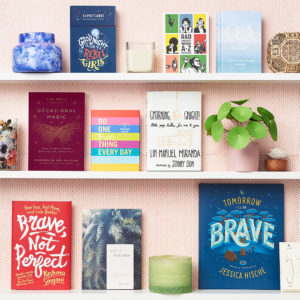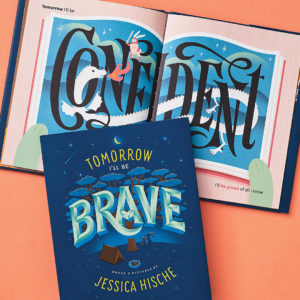
We are turning the spotlight on Penguin Random House as our featured Maker this month! Learn more about their story and how they build their community of authors.
“At Penguin Random House we foster a passion for books and gifts by partnering with authors and artists to bring stories to life and communicate ideas that inspire, connect and entertain.” With those guiding principles, they are able to curate a collection of relatable and unique stories including that of Jessica Hische the author of Tomorrow I’ll Be Brave.
Below is our interview with Penguin Random House that gives us an inside look at the brand and an exclusive interview with Jessica!
What is the mission of Penguin Random House?
Penguin Random House is the international home to nearly 250 editorially and creatively independent publishing imprints. Together, our mission is to foster a universal passion for reading by partnering with authors to help create stories and communicate ideas that inform, entertain, and inspire, and to connect them with readers everywhere.
How does the curation process look for your brand?
Our team are committed to helping authors realize their very best work and to finding innovative new ways of bringing stories and ideas to audiences worldwide. By leveraging our global reach, embracing new technologies, and collaborating with authors at every stage of the publishing process—from editorial and design, to sales and marketing, to production and distribution—we aim to provide them with the greatest platform possible.
What trends are you seeing in story-telling?
We challenge ourselves every day to respond to stories and ideas that ignite the imagination, celebrate diversity, trigger creativity and reflect our belief in the power of books to connect and change lives, whether we’re publishing cookbooks, business books, pop culture, children’s books, gifts or stationery. These days, we’re finding empowerment, wellness, creativity, and organization at the forefront.

Jessica Hische, Author & Illustrator of Tomorrow I’ll Be Brave
What was the inspiration behind Tomorrow I’ll be Brave?
As someone who grew up loving art and went on to pursue an education and career in the arts (specifically graphic design and illustration), people had always asked me if I would create kids book some day. Until I had my daughter in 2015, my answer was always an ambivalent “Maybe?”—I love making personal passions about things Iʼm interested in or am learning about and I didnʼt feel comfortable working on a kidʼs book until having a child myself—I had to reconnect with the world of childrenʼs books after a long hiatus.
We read to my daughter endlessly—she learned how to turn pages herself at around 7 months and it felt like this magical moment when she became a “tiny person” instead of a baby. It brought back memories of some of my favorite books as a kid, and also made me realize that there is a bottomless pit of need for new childrenʼs books. My wheels started turning about what I would want to do if I were to make a book.
I thought a lot about what I was like as a kid—how I was born with a very strong variant of the “people pleaser gene”. I worried so much about “getting it right” that I often held myself back from trying new things. I never had to be punished for doing something wrong because I was harder on myself than anyone else could be. I also thought a lot about the quiet work that I do as a professional, the work that isnʼt in my portfolio but what brings me some of the most joy—advising, teaching, and encouraging those younger than me through rough patches of their careers and helping them push through the fears and doubts that hold them back. I looked at my daughter and saw a lot of myself in her. She was so small but I could see bits of the “people pleaser gene” emerging. I wanted to make something that spoke to her and to my younger self—something that was encouraging but also introduced a really important concept that everyone struggles with—self-forgiveness when you donʼt achieve your goals. I thought about how many kids are told they can be and do anything, but that parents donʼt always have the tools to talk through failure with them and teach them that failure is important and a huge part of learning.
The core of Tomorrow Iʼll be Brave is about setting intentions, celebrating achievements, and overcoming and processing setbacks. Parents often get their kids to go to bed by talking through the excitement that tomorrow will bring, and it felt like a great moment to create this beautiful closed loop of intention and reflection. If it had been “Today Iʼll be…” there would never be a moment set aside to stop and reflect.
What were the key messages or words you wanted to highlight in this book?
I did a lot of preliminary research and list making about what positive attributes I wanted to highlight. I actually found a giant list of them someone had compiled online and started narrowing it down based on things I thought would resonate most with kids and their parents. In the end I had about 15–20 words, and from that I picked words that worked well together. All of the words in Brave have a very get-up-and-go effervescent energy to them. Theyʼre words that specifically affect the child/reader and how they feel about themselves. Adventurous, Strong, Smart, Curious, Creative, Confident, Brave.
I had a second list of words with a very different energy—a low burning warmth. This second set had to do with the childʼs relationship with the people around them. Thereʼs another book in the works for this set, which I see as the second side to the same coin. Brave helps you feel good about yourself and what you can personally set out and achieve and this second book takes that momentum to help you do good for the world and those around you.
What does your creative process look like when you start a new project?
It definitely depends on the project—for a book project like this I start as author and end as illustrator. I brainstorm, write, re-write (and re-write some more) until my manuscript is close enough that my illustrator self can step in. When Iʼm illustrating and lettering, I have a fairly regimented process of research (in this case, reading my own manuscript as if itʼs coming from a client and not my own brain), brainstorming, sketching, and then finalizing the art. I do most of my sketching on an iPad Pro these days, and create all of my final art in Adobe Illustrator by tracing my sketches. Itʼs a pretty meticulous process but slowing myself down really helps me as I create—I add nuance and detail that wouldnʼt happen if I had a speedier way of doing things.
How do you feel about being a New York Times Bestselling Author?
Itʼs pretty surreal—I donʼt know if itʼs even fully set in all these months later. I have been lucky enough to have collected a few accolades over the course of my career, but this feels different. Itʼs a permanent line in your biography—and I donʼt think anything Iʼve achieved so far has hit that status.
Were there any moments on your journey where it was difficult to be Brave?
Itʼs hard to keep count of them! I’m a relatively risk averse person, so pushing myself to get out of my comfort zone on projects can be difficult. I think the biggest challenge Iʼve had in recent memory was actually releasing Tomorrow Iʼll be Brave into the world. I felt emotionally connected to the book and vulnerable in a way that I hadnʼt in a really long time. I can normally separate myself from my work, which helps fortify me against criticism, but Brave was different. It had so much to do with who I was, who I’m, and what I want to contribute to the world that I couldnʼt separate myself from the work. Iʼve been over the moon that itʼs found an audience and that itʼs resonated with people, but it was definitely scary to make something that I was so personally connected to.
What advice do you have for illustrators and designers pursuing their careers?
Do what you can to look within for inspiration instead of outward. It’s easy to feel lost or a million miles behind yoru peers if you spend too much time watching other people’s careers from the bleachers, especially on social media. The times in my life in which I’ve made the work I was most proud of and the times in which I’ve felt I was a few steps ahead instead of a few steps behind, were when I could shut out the rest of the world and focus on what I was personally driven to make rather than reacting to what I saw around me.
Looking to create your story? Shop our curated collection of inspiring books, journals and note cards from Penguin Random House including How to Breathe, The Moth Occasional Magic and GMorning, GNight! by Lin-Manuel Miranda.


